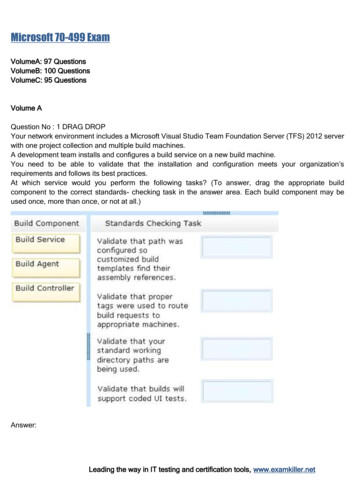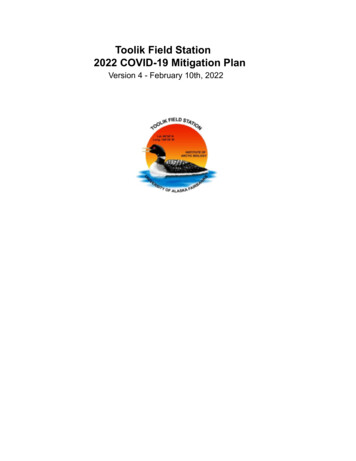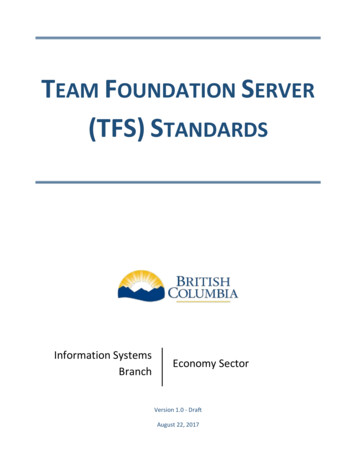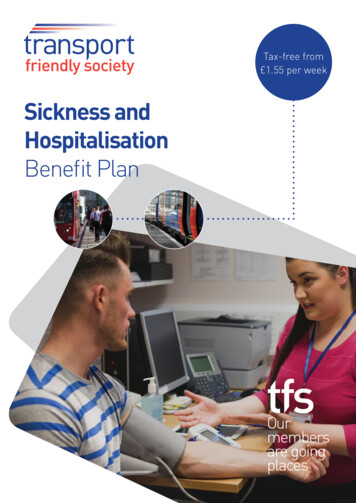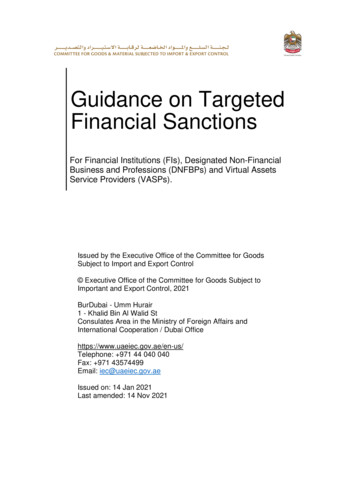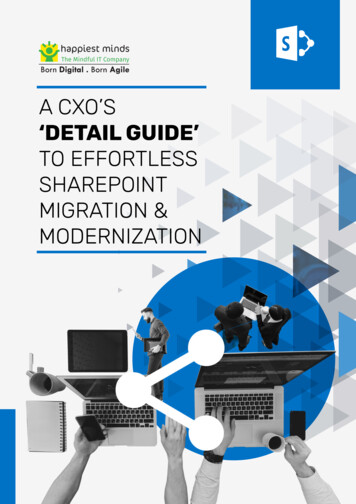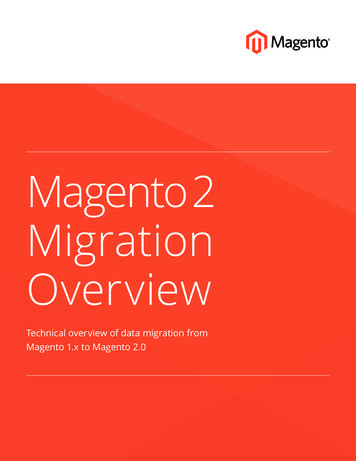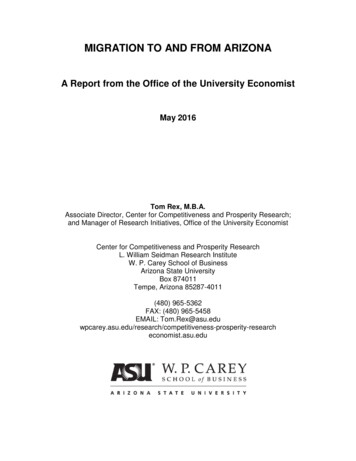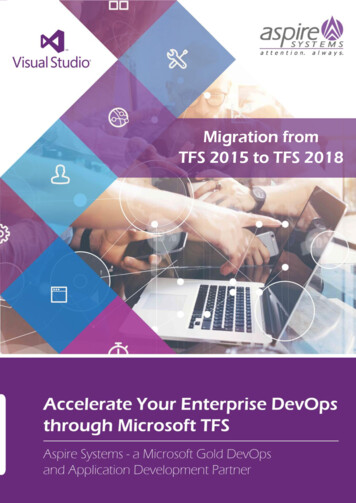
Transcription
Page 0
ContentsExecutive Summary .2Steps to Upgrade from SQL Server 2014 to SQL Server 2018 .2In place Migration from TFS 2015 to TFS 2018 .8Permission Requirements .8Set Administrator Permissions for Team Foundation Server .8To add a member to the Team Foundation Administrators security group: .9To add a member to the Reporting Services Content Manager and System Administrator roles .9Set Administrator Permissions for Windows SharePoint Services. 10Upgrade Process . . 10Conclusion . 20Page 1
Executive SummaryTFS 2018 brings with it many features and advantages that were not compatible/or were unavailablein TFS 2015 thereby making a strong case for upgradation to the latter from the former. Not onlydoes it offer improved Project Creation Wizard and Process Template Manager on the web, but it alsofacilitates flexibility by enabling the customization of the work item form header. A few of the othernotable takeaways of TFS 2018 include improved Wiki experience, refined pull requests, optimizedmobile work item form, enhanced exploratory testing traceability, and the option to deploy withvirtual machine deployments.For TFS upgradation, the SQL server and the report server needs to be upgraded with the compatibleSQL server version for the TFS 2018.Steps to Upgrade from SQL Server 2014 to SQL Server 2018 Insert the SQL Server installation media, and from the root folder, double-click Setup.exe.To install from a network share, move to the root folder on the share, and then doubleclick Setup.exe The Installation Wizard initiates the SQL Server Installation Center. To upgrade an existinginstance of SQL Server, select Installation in the left-hand navigation area, and thenclick Upgrade from a previous version of SQL ServerPage 2
On the Product Key page, select an option to indicate whether you are upgrading to afree edition of SQL Server, or if you have a PID key for a production version of the product On the License Terms page, review the license agreement and, upon agreement, selectthe I accept the license terms check box, and then click Next In the Global Rules window, the setup procedure will automatically advance to theProduct Updates window if there are no rule errors On the Product Updates page, the latest available SQL Server product updates aredisplayed. If you don't want to include the updates, uncheck the Include SQL Serverproduct updates check box. If no product updates are discovered, SQL Server Setup doesnot display this page and the process auto advances to the Install Setup Files page On the Install Setup Files page, the setup provides the options of downloading,extracting, and installing the setup files. If an update for SQL Server Setup is found, and isspecified to be included, then that update will also be installed In the Upgrade Rules window, the setup procedure will automatically advance to theSelect instance window if there are no rule errors On the Select Instance page, specify the instance of SQL Server to upgrade. To upgradeManagement tools and shared features, select Upgrade shared features only On the Select Features page, the features to upgrade will be pre-selected. A descriptionfor each component group appears in the right pane after a feature name is selected The prerequisites for the selected features are displayed on the right-hand pane. SQLServer Setup will install the prerequisite that are not already installed during theinstallation step (Described later in this procedure) If you have opted to upgrade the shared features by selecting Upgrade shared featuresonly on the Select Instance page, all the shared features are preselected on the FeatureSelection page. All the shared components are upgraded simultaneously On the Instance Configuration page, specify the Instance ID for the instance of SQL Server Instance ID — by default, the instance name is used as the Instance ID. This is used toidentify the installation directories and registry keys for your instance of SQL Server. This isthe case for default instances and named instances. For a default instance, the instancename and instance ID would be MSSQLSERVER. To use a non-default instance ID, a valuewould be needed for the Instance ID textboxPage 3
All the SQL Server service packs and upgrades will apply to every component of aninstance of SQL Server Installed instances — the grid will show instances of SQL Server that are on the systemwhere the setup is running. If a default instance is already installed on the system, youmust install a named instance of SQL Server On the Server Configuration — Service Accounts page, the default service accounts aredisplayed for SQL Server services. The actual services that are configured on this pagedepend on the features that you are upgradingPage 4
Authentication and login information will be carried forward from the previous instanceof SQL Server. You can assign the same login account to all SQL Server services, or youcan choose to configure each service account individually. You can also specify whetherthe services start automatically, or manually, or are disabled. Microsoft recommends thatyou configure service accounts individually so that SQL Server services are granted theminimum permissions they have to have to complete their tasks To specify the same login account for all service accounts in this instance of SQL Server,provide credentials in the fields at the bottom of the page Security Note: Do not use a blank password. Use a strong password. When you are finished specifying login information for SQL Server services, click Next On the Full-Text Search Upgrade Options page, specify the upgrade options for thedatabases that are being upgradedPage 5
The Feature Rules window will automatically advance if all rules pass The Ready to upgrade page displays a tree view of installation options that were specifiedduring Setup. To continue, click Install. SQL Server Setup will first install the requiredprerequisites for the selected features followed by the feature installation During installation, the progress page provides status so that you can monitor installationPage 6
After installation, the end page provides a link to the summary log file for the installationand other important notes. To complete the SQL Server installation process, click Close. If you are instructed to restart the computer, proceed and do so. It is important to read themessage from the Installation Wizard when you have finished with Setup.Page 7
In place Migration from TFS 2015 to TFS 2018This upgrade document gives a detailed step-by-step procedure for the In-Place upgrade from TFS2015 to 2018 RTM with Reporting and SharePoint.There is no need for a manual transfer of data or settings as the Setup automatically upgrades dataand settings in place. The resulting upgraded instance has the same name as the original and theconcerned Applications continue to connect to the same instance name. For small data sets, thecumulative end-to-end time might be shorter as this is the most automated upgrade strategy. Therecould be a shortage of disk space in production because, with a single resulting instance, there is lessadditional data space required than is possible with two complete resulting instances running side byside.Environment DetailsTFS 2015 environmentWindows server 2012 R2, TFS 2015 RTM, SQL 2014 SP1, SharePoint 2013 SP1TFS 2018 environmentWindows server 2012 R2, TFS 2018 RTM, SQL 2017, SharePoint 2013 SP1Permission RequirementsThe Account running the upgrade needs to have the following access permissions: Local Administrator on the Application Tier Local Administrator on the Reporting Tier SysAdmin on SQL Data Tier SharePoint Farm AdministratorSet Administrator Permissions for Team Foundation ServerWhen configuring a user in the Team Foundation Server administrator role, you must set permissionsin Team Foundation Server groups, Windows SharePoint Services groups, and Reporting Servicesgroups. You must also set permissions on the Team Foundation application-tier and data-tiercomputer groups as necessary. In this section, the procedure to follow to set permissions in TeamFoundation Servers for a Team Foundation Server administrator is explained.Required PermissionsTo perform this procedure, you must be a member of the Team Foundation Administrators group orhave the Edit Server-Level Information permission set to allow access.Page 8
To add a member to the Team Foundation Administratorssecurity group: In Visual Studio, open Team Foundation, and connect to the Team Foundation Server forwhich you are setting permissions Right-click the Team Foundation Server, point to Team Foundation Server Settings, andthen click Group Membership Select Server\Team Foundation Administrators and then click Properties In Add member, select Windows User or Group, and then proceed by clicking Add Add the Windows logon name for the person to whom you want to grant permissionsand then click OKBesides completing this procedure, you must also grant administrator permissions on ReportingServices and Windows SharePoint Services to add a person in the Team Foundation ServerAdministrator role.To add a member to the Reporting Services Content Managerand System Administrator roles Open Internet Explorer Type the following in the Address bar: http:// application-tier /Reports/Pages/Folder.aspx Here, the application-tier is the nameof the Team Foundation application-tier report server. You can find the name of thereport server by opening Team Explorer, expanding the Reports node, and viewing theproperties of a report Click the Properties tab and then click New Role Assignment In Group or User Name, add the Windows logon name for the person to whom you wantto grant Content Manager permissions In Role, select Content Manager, and then click OK Click Site Settings and then click Configure site wide security Click New Role Assignment In Group or User Name, add the Windows logon name for the person to whom you wantto grant System Administrator permissions In Role, select System Administrator, and then click OKPage 9
Set Administrator Permissions for Windows SharePoint ServicesRequired PermissionsTo perform this procedure, you must be a member of the Administrators group on the TeamFoundation application-tier server or a member of the SharePoint administration group.To designate a group as the SharePoint Administration group On the Team Foundation application-tier, click Start, point to Administrative Tools, andthen click SharePoint Central Administration In Central Administration, click Set SharePoint Administration Group In Set SharePoint Administration Group, type the appropriate group account name andthe domain Click OKUpgrade processAlthough this will be an in-place upgrade to TFS 2018 from TFS 2015, the requirement for theoperating system, SQL server and SharePoint remains the same for both the versions of TFS. Back upall the databases from TFS 2015, it’s recommended to take database backup before proceeding withthe upgrade.Following are the screens of the installation process:Step 1: Choosing between deployment typeAfter installing TFS 2018 binaries, the server configuration wizard will open. We no longer get theoption to select deployment type like basic, advanced, Application Tier Only at the welcome screen;instead, it automatically detects and provides you with the upgrade option if you plan to do in-placeupgrade.Page 10
Step 2: Select deployment typeSelect “I have existing databases to use for this Team Foundation Server deployment”.Step 3: Specifying TFS configuration databasesThe wizard will automatically pick the SQL server which hosts the TFS 2018 databases. If the data-tieris changed, you need to provide SQL server instance name. It is recommended that you have backupstaken before you start the upgrade. Check the box and confirm that you have current backupsPage 11
Step 4: Select Deployment scenarioUpgrade scenario has 2 options: Product upgrade and Pre-Production Upgrade Testing. Using PreProduction upgrade option, you can test the upgrade before upgrading to the product environment.This process takes care of the cloning process and changing server IDs which ensures that thisdeployment will not interfere with the production environmentIn this document, we will proceed with the production upgrade scenario.Step 5: Selecting TFS service accountProvide the service account. It can be either a Network account or a User accountPage 12
Step 6: Application Tier SettingsWebsite settingsIn TFS 2018, we have the option to choose to specify default, HTTPS and HTTP (with redirect) andonly HTTP.SSH settingsTo support SSH Protocol for GIT, we need to enable the SSH Service and choose the port. By default,port 22 will be used.If you choose HTTPS and HTTP (with redirect), the wizard gives the option to choose certificate orgenerate self-signed certificate.Page 13
Step 7: Code Search configurationSpecify a folder to store the index, and choose if you want to enable code search for every projectcollection. You can use the elastic search feature of the earlier version of TFS i.e., RC and RC1.Step 8: Configuring ReportingSelect the checkbox to configure reporting services.Page 14
Step 9: Providing settings for Reporting servicesPopulate the URL for reporting service configuration and validate the URL by browsing to the URLthrough a browser.Step 10: Specifying Warehouse DatabaseClick on List Available Databases hyperlink. Select the valid Warehouse database and click Next.Page 15
Step 11: Setting Analysis instanceEnter analysis instance name and proceed.Step 12: Setting account for reportsIf you had used Network Service as TFS Service account, then we must specify a different accounthere as we cannot use Network Service as TFS Reports Reader account.Page 16
Step 13: Setting for SharePointSelect the checkbox to integrate with SharePoint. Select the default setting and proceed.Note: If you have a remote SharePoint server, you must have the extensions for SharePoint Productsinstalled and configured them, prior to running this wizard.Step 14: Confirming settingsConfirm the setting before proceeding to the next step.Page 17
Step 15: Readiness checkThe verification process identifies errors and warnings. These errors should be fixed beforeproceeding further.Note for warnings:1. Since Elastic Search depends on Java, if you do not have Java JRE or JDK installed on the machine,the wizard gives you an error during the verification process. Accept license and wizard2. It’s recommended to have disk space of at least 50 GB that has AT file cache folderPage 18
Step 16: Configuring the updateStep 17: Finishing the upgradePage 19
ConclusionAspire Systems is a Microsoft Gold certified partner for DevOps competency. With the expertisespanning over many years, we specialize in the entire process ranging from the initial TFSconsultation phase to the final end-to-end activities, and everything in between, and haveimplemented TFS successfully for many of our clients. Install an appropriate version of SharePoint.About Aspire Global technology services firm with core DNA of Software Engineering Specific areas of expertise around Software Engineering, Digital Services, Testing andInfrastructure & Application Support Vertical focus among Independent Software Vendors and Retail, Distribution & ConsumerProducts 2400 employees; 150 active customersCMMI Maturity Level 3, ISO 9001:2015, ISO 270001: 2013 certified Aspire has extended its global presence across North America, Europe, APAC, and theMiddle East Recognized 9 consecutive times as “Best Place to Work for” by GPW InstitutePage 20
SQL server version for the TFS 2018. Steps to Upgrade from SQL Server 2014 to SQL Server 2018 Insert the SQL Server installation media, and from the root folder, double-click Setup.exe. . free edition of SQL Server, or if you have a PID key for a production version of the product On the License Terms page, review the license agreement and .
